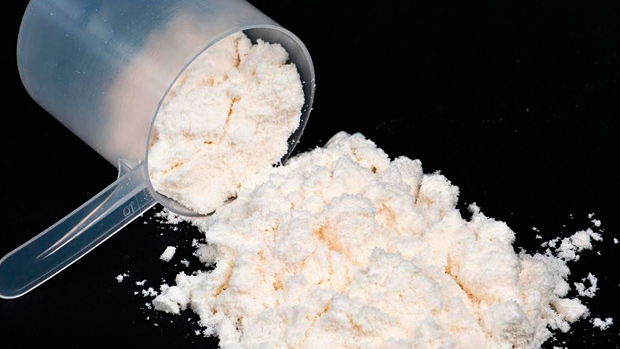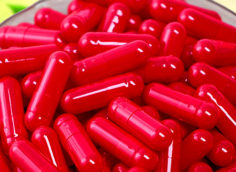We first published an article about how soy protein is estrogenic, can lower Testosterone counts, and can even kill testicular cells in January of 2000. We then published new research on the matter in February of 2001. But you know something? The national media still won't touch the story. You can pick up the "Food" section of practically any local newspaper and see glowing reviews of the healthy attributes of soy protein, complete with yummy, Testosterone-lowering recipes.
Likewise, the other weightlifting and bodybuilding mags still tout its benefits, and a week doesn't go by that we don't get a letter from some irate soy fan who ends up questioning our parentage.
Given all that, we think that the topic deserves to be visited again and again until every man, woman, and child knows the truth. Hence this new article on soy. Oh, and make sure you read the letter that follows the article. It was written by two of the Food and Drug Administration's soy experts who attempted to stop FDA approval of soy.
There's a lot of talk today about soy. Turn on the news and its soy, read a diet book and you'll find soy, go to your local gym and a personal trainer will recommend soy. What is it about soy that has captivated this nation? Well for starters it has many health benefits backed up by good science, it's inexpensive, it has a good track record in Asia, and the government has allowed a seal of approval to be stamped on food items that contain 6.25 grams of soy protein.
Sounds like soy is a "can't miss" product, but is it? In this article we'll uncover the darker side of supposedly innocent soy and show you why you might not choose to include it in your otherwise healthy diet.
Many papers have exhorted the benefits of soy, but as the saying goes "if it sounds too good to be true, it probably is" fits soy better than anything else you might imagine.
Science has shown soy, more importantly its phyto-estrogen components, namely genistein, has the ability to attach to estrogen receptor sites and through transcription, act as female hormones such as estradiol. This, in some cases, can have benefits so it's not strange that soy would receive some well-deserved attention. The problem with this attention is that individuals who have no need of soy, and even some to which soy could be hazardous, have started using it. Science is now beginning to see what this "benign" protein can do, though.
This review will cover the negative effects that soy protein may have on fetal development of both males and females, hormonal balance in males of a pre-mature and mature age, and efforts of weight training individuals trying to increase fat-free muscle mass. Studies will be included of human and non-human species, both immature and mature in age. Only abstracts and full-length articles from peer reviewed journals will be referenced in this paper.
Literature
Both abstracts and journals were found through the PubMed database and in the local university library. Limits were set on searches such as "human only," "male," "female," "abstract only," and others. Key words used included "soy," "soy protein," "genistein," as well as "Testosterone production," "effects on Testosterone," and others. Finally, studies or points in favor of soy were not included, as countless papers have been written on its positive effects.
Findings
The largest concern scientists have about soy are its effects on sexual development of infants consuming soy-based formula. The data is startling, yet most concerns have fallen on deaf ears.
One study showed that when manufacturer-suggested amounts of soy formula are fed to infants, the infants ingest a daily dose of approximately 3 mg of total isoflavones (i.e. genistein and daidzein) per kg of body weight, which is maintained at a fairly constant level between 0 and 4 months of age.(3) Supplementing the diet of 4-month old infants with a single daily serving of soy-based cereal can increase their isoflavone intake by over 25%, depending on the brand chosen.
This rate of isoflavone intake is much greater than that shown to alter reproductive hormones in adult humans. The available evidence suggests that infants can digest and absorb dietary phytoestrogens in active forms and neonates are generally more susceptible than adults to perturbations of the sex-steroid milieu.
Another study assessed the effect of administering neonatal animals genistein in the amount of 4 mg per kg per day from days 2-18 of life.(1) Administration of genistein significantly retarded most measures of pubertal spermatogenesis. Plasma FSH levels in the treatment groups changed in parallel to the spermatogenic changes (reduced when pubertal spermatogenesis retarded, increased when pubertal spermatoenesis advanced).
By day 25, the changes in FSH levels largely persisted. In adulthood, the animals that were fed a soy-free diet in infancy and on, had significantly larger testes than controls fed a soy-containing diet. Of the animals that had neonatal treatment with genistein, a minority did not mate or were infertile.
In concluding this article, the authors stated "the presence or absence of soy or genistein in the diet has significant short-term (pubertal spermatogenesis) and long-term (body weight, testis size, FSH levels, and possibly mating) effects on males."
The ugliness continues. The developing fetus is uniquely sensitive to perturbation with estrogenic chemicals. The carcinogenic effect of prenatal exposure to diethylstilbestrol (DES) is the classic example. The carcinogenic potential of genistein, a naturally occurring plant estrogen in soy, has been shown in mice treated neonatally. In a study reported in the journal, Cancer Research, the incidence of uterine adenocarcinoma in 18-month-old mice was 35% for genistein and 31% for DES (diethylstilbestrol).(6)
This data suggests that genistein is carcinogenic if exposure occurs during critical periods of differentiation. The author admonished: "Thus, the use of soy-based infant formulas in the absence of medical necessity and the marketing of soy products designed to appeal to children should be closely examined."
Finally, as far as soy and its effects on infants, hypothyroidism has been shown in infants receiving soy formula.(2)
The next major concern is genistein's estrogenic and anti-androgenic effects on adult male animals and humans. This effect was shown clearly in a study on adult male reproductive tracts.(8) In intact adult male mice, genistein (2.5 mg per kg of body weight per day for only 9 days) reduced testicular and serum Testosterone concentrations and pituitary LH-content. These results suggest that genistein – in doses comparble to those that would exist in a soy-based diet – induced typical estrogenic effects.
A second study showed plasma Testosterone and androstenedione levels were significantly lower in the animals fed a phytoestrogen-rich diet compared with animals fed a phytoestrogen-free diet.(9) These results indicated that consumption of dietary phytoestrogens over a relatively short period can significantly alter plasma androgen hormone levels.
In a study of Japanese men, total and free Testosterone concentrations were inversely correlated with soy product intake. (5)
The evidence continues. In rats that were fed a diet in which casein was replaced by soy protein isolate/isoflavones, both serum levels of Testosterone and weight of testes were significantly reduced.(7)
Finally, in a study that may correlate more strongly with weight-training athletes, diets that consist of inferior protein (soy) may increase protein breakdown in skeletal muscle.(4) Pigs were fed diets based on soybean-protein isolate or casein for 15 weeks. A transient rise in the level of cortisol was shown to occur in the postprandial phase only in the soybean group. The authors of this study concluded: "These data suggest that the inferior quality of dietary soybean protein induces hormonally-mediated upregulation of muscle protein breakdown for recruitment of circulatory amino acids in a postabsorptive state."
In other words, soy intake induces the body to break down muscle protein in order for it to get its required amino acids.
Conclusions
At this time it's recommended that:
- Infants not be given soy-based formula until more research is done on safety in regard to neonatal sexual development and its effects on thyroid suppression.
- Men not use soy products until more research is done on its effects on Testosterone and testicular function.
- Weight-training individuals who hope for increased muscle hypertrophy not use soy protein until more research is done on effects of decreased Testosterone, increased cortisol levels and muscle protein breakdown.
Scientists Protest Soy Approval in Unusual Letter
Scientists' Letter
DEPARTMENT OF HEALTH and HUMAN SERVICES Public Health Service Food and Drug Administration National Center For Toxicological Research Jefferson, Ark. 72079-9502 Daniel M. Sheehan, Ph.D. Director, Estrogen Base Program Division of Genetic and Reproductive Toxicology and Daniel R. Doerge, Ph.D. Division of Biochemical Toxicology February 18, 1999 Dockets Management Branch (HFA-305) Food and Drug Administration Rockville, MD 20852
To whom it may concern,
We are writing in reference to Docket # 98P-0683; "Food Labeling: Health Claims; Soy Protein and Coronary Heart Disease." We oppose this health claim because there is abundant evidence that some of the isoflavones found in soy, including genistein and equol, a metabolize of daidzen, demonstrate toxicity in estrogen sensitive tissues and in the thyroid. This is true for a number of species, including humans.
Additionally, the adverse effects in humans occur in several tissues and, apparently, by several distinct mechanisms. Genistein is clearly estrogenic; it possesses the chemical structural features necessary for estrogenic activity (; Sheehan and Medlock, 1995; Tong, et al, 1997; Miksicek, 1998) and induces estrogenic responses in developing and adult animals and in adult humans.
In rodents, equol is estrogenic and acts as an estrogenic endocrine disruptor during development (Medlock, et al, 1995a,b). Faber and Hughes (1993) showed alterations in LH regulation following this developmental treatment with genistein. Thus, during pregnancy in humans, isoflavones per se could be a risk factor for abnormal brain and reproductive tract development.
Furthermore, pregnant Rhesus monkeys fed genistein had serum estradiol levels 50- 100 percent higher than the controls in three different areas of the maternal circulation (Harrison, et al, 1998). Given that the Rhesus monkey is the best experimental model for humans, and that a women's own estrogens are a very significant risk factor for breast cancer, it is unreasonable to approve the health claim until complete safety studies of soy protein are conducted.
Of equally grave concern is the finding that the fetuses of genistein fed monkeys had a 70 percent higher serum estradiol level than did the controls (Harrison, et al, 1998). Development is recognized as the most sensitive life stage for estrogen toxicity because of the indisputable evidence of a very wide variety of frank malformations and serious functional deficits in experimental animals and humans.
In the human population, DES exposure stands as a prime example of adverse estrogenic effects during development. About 50 percent of the female offspring and a smaller fraction of male offspring displayed one or more malformations in the reproductive tract, as well as a lower prevalence (about 1 in a thousand) of malignancies.
In adults, genistein could be a risk factor for a number of estrogen-associated diseases. Even without the evidence of elevated serum estradiol levels in Rhesus fetuses, potency and dose differences between DES and the soy isoflavones do not provide any assurance that the soy protein isoflavones per se will be without adverse effects.
First, calculations, based on the literature, show that doses of soy protein isoflavones used in clinical trials which demonstrated estrogenic effects were as potent as low but active doses of DES in Rhesus monkeys (Sheehan, unpublished data). Second, we have recently shown that estradiol shows no threshold in an extremely large dose-response experiment (Sheehan, et al, 1999), and we subsequently have found 31 dose-response curves for hormone-mimicking chemicals that also fail to show a threshold (Sheehan, 1998a).
Our conclusions are that no dose is without risk; the extent of risk is simply a function of dose. These two features support and extend the conclusion that it is inappropriate to allow health claims for soy protein isolate. Additionally, isoflavones are inhibitors of the thyroid peroxidase which makes T3 and T4. Inhibition can be expected to generate thyroid abnormalities, including goiter and autoimmune thyroiditis. There exists a significant body of animal data that demonstrates goitrogenic and even carcinogenic effects of soy products (cf., Kimura et al., 1976). Moreover, there are significant reports of goitrogenic effects from soy consumption in human infants (cf., Van Wyk et al., 1959; Hydovitz, 1960; Shepard et al., 1960; Pinchers et al., 1965; Chorazy et al., 1995) and adults (McCarrison, 1933; Ishizuki, et al., 1991).
Recently, we have identified genistein and daidzein as the goitrogenic isoflavonoid components of soy and defined the mechanisms for inhibition of thyroid peroxidase (TPO)- catalyzed thyroid hormone synthesis in vitro (Divi et al., 1997; Divi et al., 1996). The observed suicide inactivation of TPO by isoflavones, through covalent binding to TPO, raises the possibility of neoantigen formation and because anti-TPO is the principal autoantibody present in auto immune thyroid disease. This hypothetical mechanism is consistent with the reports of Fort et al. (1986, 1990) of a doubling of risk for autoimmune thyroiditis in children who had received soy formulas as infants compared to infants receiving other forms of milk.
The serum levels of isoflavones in infants receiving soy formula that are about five times higher than in women receiving soy supplements who show menstrual cycle disturbances, including an increased estradiol level in the follicular phase (Setchell, et al, 1997). Assuming a dose-dependent risk, it is unreasonable to assert that the infant findings are irrelevant to adults who may consume smaller amounts of isoflavones.
Additionally, while there is an unambiguous biological effect on menstrual cycle length (Cassidy, et al, 1994), it is unclear whether the soy effects are beneficial or adverse. Furthermore, we need to be concerned about transplacental passage of isoflavones as the DES case has shown us that estrogens can pass the placenta. No such studies have been conducted with genistein in humans or primates. As all estrogens which have been studied carefully in human populations are two-edged swords in humans (Sheehan and Medlock, 1995; Sheehan, 1997), with both beneficial and adverse effects resulting from the administration of the same estrogen, it is likely that the same characteristic is shared by the isoflavones. The animal data is also consistent with adverse effects in humans.
Finally, initial data fi-om a robust (7,000 men) long-term (30+ years) prospective epidemiological study in Hawaii showed that Alzheimer's disease prevalence in Hawaiian men was similar to European-ancestry Americans and to Japanese (White, et al, 1996a). In contrast, vascular dementia prevalence is similar in Hawaii and Japan and both are higher than in European-ancestry Americans.
This suggests that common ancestry or environmental factors in Japan and Hawaii are responsible for the higher prevalence of vascular dementia in these locations. Subsequently, this same group showed a significant dose-dependent risk (up to 2.4 fold) for development of vascular dementia and brain atrophy from consumption of tofu, a soy product rich in isoflavones (White, et al, 1996b).
This finding is consistent with the environmental causation suggested from the earlier analysis, and provides evidence that soy (tofu) phytoestrogens causes vascular dementia. Given that estrogens are important for maintenance of brain function in women; that the male brain contains aromatase, the enzyme that converts testosterone to estradiol; and that isoflavones inhibit this enzymatic activity (Irvine, 1998), there is a mechanistic basis for the human findings. Given the great difficulty in discerning the relationship between exposures and long latency adverse effects in the human population (Sheehan, 1998b), and the potential mechanistic explanation for the epidemiological findings, this is an important study.
It is one of the more robust, well-designed prospective epidemiological studies generally available. We rarely have such power in human studies, as well as a potential mechanism, and thus the results should be interpreted in this context. Does the Asian experience provide us with reassurance that the isoflavones are safe? A review of several examples lead to the conclusion, – "Given the parallels with herbal medicines with respect to attitudes, monitoring deficiencies, and the general difficulty of detecting toxicities with long Iatencies, I am unconvinced that the long history of apparent safe use of soy products can provide confidence that they are indeed without risk." (Sheehan, 1998b).
It should also be noted that the claim on p. 62978 that soy protein foods are GRAS is in conflict with the recent return by CFSAN to Archer Daniels Midland of a petition for GRAS status for soy protein because of deficiencies in reporting adverse effects in the petition. Thus GRAS status has not been granted. Linda Kahl can provide you with details. It would seem appropriate for FDA to speak with a single voice regarding soy protein isolate. Taken together, the findings presented here are self-consistent and demonstrate that genistein and other isoflavones can have adverse effects in a variety of species, including humans. Animal studies are the front line in evaluating toxicity, as they predict, with good accuracy, adverse effects in humans.
For the isoflavones, we additionally have evidence of two types of adverse effects in humans, despite the very few studies that have addressed this subject. While isoflavones may have beneficial effects at some ages or circumstances, this cannot be assumed to be true at all ages. Isoflavones are like other estrogens in that they are two-edged swords, conferring both benefits and risk (Sheehan and Medlock, 1995; Sheehan, 1997).
The health labeling of soy protein isolate for foods needs to considered just as would the addition of any estrogen or goitrogen to foods, which are bad ideas. Estrogenic and goitrogenic drugs are regulated by FDA, and are taken under a physician's care. Patients are informed of risks, and are monitored by their physicians for evidence of toxicity. There are no similar safeguards in place for foods, so the public will be put at potential risk from soy isoflavones in soy protein isolate without adequate warning and information.
Finally, NCTR is currently conducting a long-term multigeneration study of genistein administered in feed to rats. The analysis of the dose range-finding studies are nearly complete now. As preliminary data, which is still confidential, may be relevant to your decision, I suggest you contact Dr. Barry Delclos at the address on the letterhead, or email him.
Sincerely,
Daniel M. Sheehan
Daniel R. Doerge
References
- Atanassova N (2000). Comparative Effects of Neonatal Exposure of Male Rats to Potent and Weak (Environmental) Estrogens on Spermatogenesis at Puberty and the Relationship to Adult Testis Size and Fertility: Evidence for Stimulatory Effects of Low Estrogen Levels. Endocrinology Vol. 141, No. 10 3898-3907
- Chorazy PA (1995). Persistent hypothyroidism in an infant receiving a soy formula: case report and review of the literature. Pediatrics Jul: 96 (1 Pt 1): 148-50
- Irvine CHG (1998). Phytoestrogens in soy-based infant foods: concentrations, daily intake, and possible biological effects. Proc Soc Exp Biol Med1998 Mar; 217 (3): 247-53)
- Lohrke B (2001). Activation of skeletal muscle protein breakdown following consumption of soybean protein in pigs. Br J Nutr 2001 Apr; 85 (4): 447-57
- Nagata C (2000). Inverse association of soy product intake with serum androgen and estrogen concentrations in Japanese men. Nutr Cancer; 36 (1): 14-8
- Newbold RR (2001). Uterine Adenocarcinoma in Mice Treated Neonatally with Genistein. Cancer Research 61, 4325-4328
- Pollard M (2000). Prevention of spontaneous prostate-related cancer in Lobund-Wistar rats by soy protein isolate/isoflavone diet. Prostate 2000 Oct 1; 45 (2): 101-5
- Strauss L (1998). Genistein exerts estrogen-like effects in male mouse reproductive tract. Mol Cell Endocrinol Sep 25; 144 (1-2): 83-93
- Weber KS (2001). Dietary soy-phytoestrogens decrease testosterone levels and prostate weight without altering LH, prostate 5alpha-reductase or testicular steroidogenic acute regulatory peptide levels in adult male Sprague-Dawley rats. J Endocrinol Sep; 170 (3): 591-9




